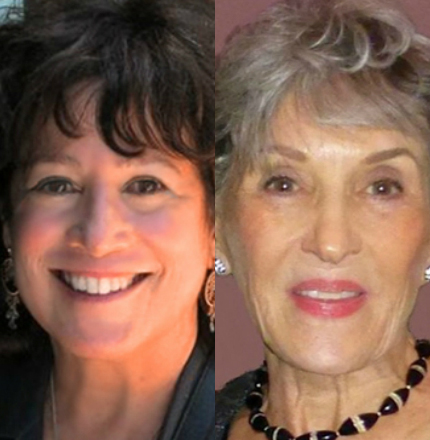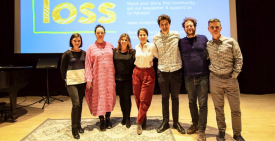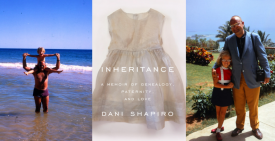When her last surviving family member dies, Joey Lerner moves from New York to Los Angeles, hoping to start over. Soon she stumbles, literally, into the job of leading a grief group for young widows and widowers at a community center called Oasis. At first the job makes Joey feel overwhelmed and underqualified, but she and the group slowly settle in to one another, and begin to recognize the value of grieving and healing within a community in which everyone is missing someone.
This is the story explored by Linda Schreyer and Jo-Ann Lautman in their novel Tears and Tequila. Linda is an award-winning composer, screenwriter and writing teacher based in Los Angeles. Jo-Ann is a native Angeleno and founder of Our House, a groundbreaking independent grief support center.
Modern Loss spoke with Linda and Jo-Ann about loss, LA, and their experience collaborating on a first novel.

Linda Schreyer (left) and Jo-Ann Lautman (right), authors of Tears and Tequila.
Modern Loss: As someone from L.A., I loved the name “Oasis” as the setting for the grief group in your novel. Very appropriate for a safe space in such a difficult desert city. Why did you choose to set this novel in LA?
Linda: In the 1990’s I started teaching writing at Everywoman’s Village, a sweet and funky community center. Two weeks later, it closed; then it was torn down to make way for an office building. When we needed a setting for the place where Joey lands, Everywoman’s Village came back to me and Jo-Ann also remembered it. Like Joey, I came here from New York (in 1983) and hated everything about LA. Like Joey, I got lost everywhere I went. It was a pivotal time in my life (and Joey’s) and a great start for our main character to be uprooted.
Jo-Ann: I have always worked and lived in Los Angeles, except for my college years in Boston. Los Angeles is home to every possible creative option imaginable. It’s an adaptable environment in every way, but also a hectic metropolis. Oasis is a perfect setting for Tears and Tequila, a safe haven in an otherwise crazy city.
ML: How did the two of you come to collaborate on this project, and how do you think your different career experiences contributed to the novel?
Related
Linda: Jo-Ann’s experience with grief groups was the inspiration for the group in Oasis. My experience of writing soap operas — with dozens of characters in interweaving storylines — combined with Jo-Ann’s wealth of experience with grievers and made us a terrific combination.
Jo-Ann: Linda and I have a strong mutual respect and affection. She is a brilliant writer, I am a grief maven, and our unique connection helped create this special book.
In 1980 I was beginning my work in Hospice care at Cedars Sinai Medical Center. One particular group grabbed my attention and my heart: young people, ages 20 to 40, with a spouse that was terminally ill. People assumed that because they were young and could meet someone else, or because they hadn’t been married for decades, that they had it easier than someone older who had a spouse die. But in fact they didn’t. The pain and confusion of these young people was the most profound that I have seen.
I told some of the administrators my experience, and they immediately offered me the chance to lead a grief group at their center. The groups grew over the years, and it became clear that I needed to establish a free-standing, independent grief center, one not affiliated with any hospital, church, or synagogue. I did so, and decided to call it “Our House,” because I wanted the people who came to feel it was really their own. “Our House” inspired the grief group in Tears and Tequila.
ML: The people within the “grief groups” all have very different ways of dealing with their losses. Did you start out wanting to represent specific reactions to death, or did you want to let the characters and their responses evolve more organically?
Linda: At first I felt like a fraud, writing about young widows and widowers. After all, that wasn’t my experience. But over time, and with Jo-Ann’s help I gained confidence in writing about them. When I realized I was born with the DNA of grief as the daughter of Holocaust survivors I settled into writing what I know. Early on, one character, Tamara, came bursting off the page. I knew her husband had killed himself and I found myself writing a scene where she’s storming through a cemetery, stepping on gravestones until she ends up at her husband’s stone where, after a year of dry-eyed grieving and rage she finally breaks down. Tamara was the first character to ‘speak’ to me. Others evolved organically over time.
ML: Were there any misconceptions about loss and grieving you were hoping to challenge with this book?
Jo-Ann: It’s something most people don’t want to think about, but young people do die. And people also go to grief groups and improve and get better. I guess the book challenges the notion that dying is only for the old. There is a time to be born and a time to die. It’s not always exactly how we plan, but it’s a fact that needs to be dealt with.
ML: What are you working on now?
Jo-Ann: I am developing a new type of group. It’s a “growth group” instead of a “loss group,” and it’s for older people who are alone and are working on who they are now, what’s next, and how to make it happen. I call it “Alone Together,” which was an earlier title for our book.
Linda: I am writing my next novel, The Goldsmith’s Daughter, about growing up in New York as the daughter of a Holocaust survivor.
Ruby Dutcher is an intern at Modern Loss.
This interview has been edited for length and clarity.












